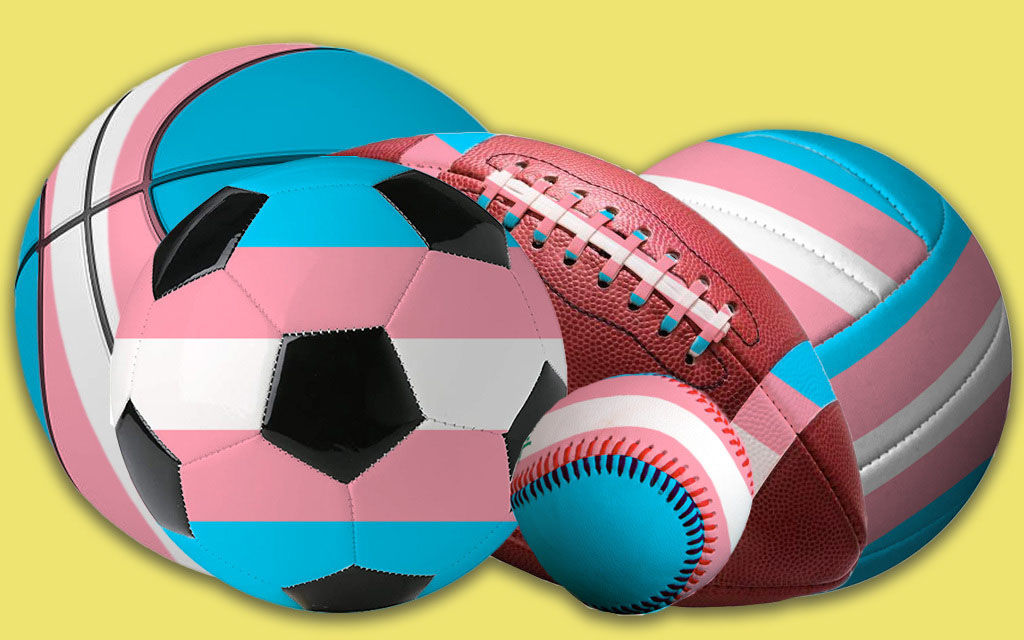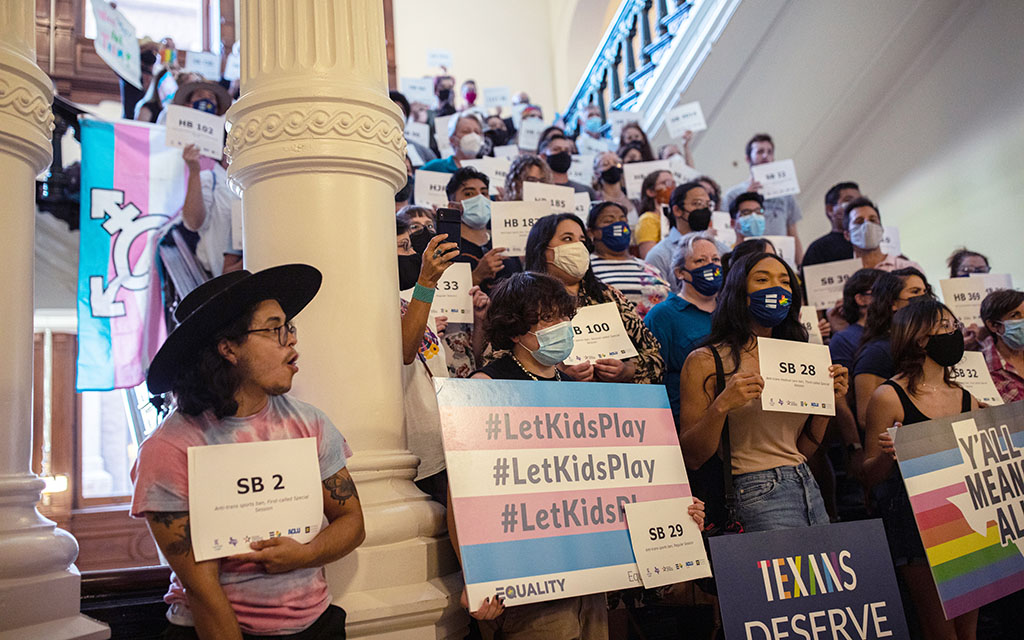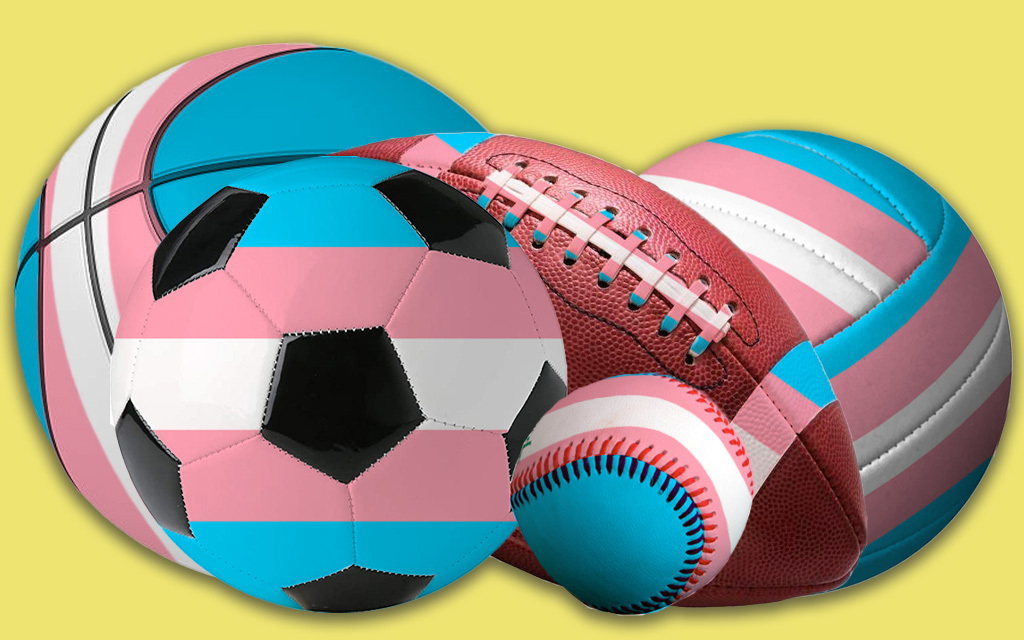PHOENIX – A federal judge in Tucson temporarily blocked the enforcement of the “Save Women’s Sports Act,” which banned transgender girls from playing on teams that align with their gender identity.
“In short, transgender girls, who have not experienced male puberty, play like girls,” U.S. District Court Judge Jennifer Zipps wrote Thursday. “There is no logical connection between prohibiting them from playing on girls sports teams and the goals of preventing unfair competition in girls sports teams or protecting girls from being physically injured by boys.”
The decision is at the center of an ongoing debate that has reached a crescendo in recent months with proposals of anti-trans athlete legislation and commentary from high-profile sports figures. But the outcry has ignored the nuances of what many experts say is a complicated and layered issue that deserves more research and thoughtful conversation about the biology and psychology of these athletes.
“There are two general responses (and) one is to deny that there are such differences … that these differences are more conventional than biological,” said Shawn Klein, an ethics and philosophy of sport professor at Arizona State University. “The second kind of response is to argue that sport should be a place for individuals to create their identity and narrative about themselves and their place in the world … biological differences should be irrelevant to participation.”
Former cycling champion Lance Armstrong raised eyebrows recently when he posed a question about the fairness of transgender athletes in the arena of competition.
“Is there not a world,” he tweeted, “in which one can be supportive of the transgender community and curious about the fairness of trans athletes in sport yet not be labeled a transphobe or a bigot as we ask questions? Do we yet know the answers? And do we even want to know the answers?”
The National Center for Transgender Equality defines a transgender individual as a person “whose gender identity is different from the gender they were thought to be when they were born.” While transgender athletes in competition is a generally new notion to the public, gender transitioning is not. Although the first documented gender reassignment surgery dates back nearly 100 years, the first transgender athlete to compete in the Olympics was New Zealand’s Laurel Hubbard in the 2020 Tokyo Games.
The questions at the roots of debate: What is the role of testosterone in athletic performance, and do the changes that the body of a transgender female undergo during puberty give her a continuous and unfair advantage? Or should biology not be considered at all since allowing participation can promote the values of non-discrimination and inclusion, and because the science is still a work in progress?
Puberty effects of testosterone
During youth athletics, gender separation is often not enforced and instead, sports are seen as a way to socialize and promote activity and movement.
The testosterone levels in girls and boys between the ages of 6 and 10 are very similar with a difference of only .5 ng/dl (nanograms per deciliter), according to a recent study published by Jonathon Senefeld of the Mayo Clinic.
During male and female puberty, testosterone levels begin to alter significantly, with females seeing levels plateauing around the age of 14 and males around 17. By the age of 20, women on average had testosterone concentration levels of 29.5 ng/dl and males 516 ng/dl.
“I don’t care what (a biological woman is) going to do, (or) how much testosterone they take, they’re never going to quite be able to compete with that biological male who went through a regular male puberty and had all those changes,” said Bobbi Lancaster, a family physician, human rights advocate and motivational speaker who competed to qualify for the LPGA Tour as the first transgender woman.

Bobbi Lancaster, a Gold Canyon doctor who underwent gender reassignment surgery in 2010, knows firsthand that the debate about transgender athletes is a complicated one. She competed to qualify for the LPGA Tour as the first transgender woman. (File photo by Reno Del Toro/Cronkite News)
Testosterone is one of the main contributors to athletic performance. Boys develop thicker and denser bones, more muscle tissue and strength, greater speed and height, and better lung capacity during puberty than girls. Aspects of these puberty advancements within males do not go away after lowering their testosterone levels.
“(When you take away testosterone) cardiac output goes down, the red blood cell mass goes down … the oxygen-carrying capacity gets reduced,” Lancaster said. “That’s why they start to perform less well.”
Some sports are starting to require that transgender female athletes have undergone puberty blockers that delay the changes of puberty-making sex hormones such as testosterone and estrogen. In 2022, USA Swimming announced a new policy that requires transgender women competing at elite levels to have low testosterone for 36 months.
“The skills central to sports are still tied to physical strength and size,” Klein said. “Individuals who have gone through male puberty, on average, will have more of these physical advantages.”
The discussion about testosterone’s advantages is a complicated one because it is not only present among those who have experienced male puberty. Some females also have high levels of testosterone that gives them performance advancements.
Beyond science
Science shouldn’t be the deciding factor in discussions about transgender participation, many others believe.
The number of trans-athletes is a very small percentage of general population numbers, with most estimates ranging from 30 to 50. During a recent debate over a bill that would block transgender girls from competing in school sports consistent with their gender identity, Rep. Bobby Scott of Virginia said there were 32 transgender athletes competing in collegiate sports, adding there are more members in the U.S. House Education and Workforce committed with 45.
As of 2022, there were 229,060 female and 293,105 male athletes competing in the NCAA, meaning transgender athletes account for about .00006% of all collegiate athletes in the U.S.
Given the small numbers, critics of the bill said the attention transgender women athletes draw makes the numbers seem inflated.
“One of the arguments is if you really care about women’s sports … protect them with a financial investment. Make sure they have equal amounts of access to funding, to the facilities at the school, etc.,” Chester said. “How is this (banning trans-athletes) keeping them safe when there’s way bigger issues outside of sports, other than trans folks who aren’t hurting or harming people.”
Critics of anti-trans bills believe those small numbers of trans women athletes should be allowed to compete because their presence will make no appreciable impact.
They stress that this is a vulnerable minority who shouldn’t be stigmatized and discriminated against and they should be allowed to participate with and nurture relationships with those whose gender they identify with.
Helen Carroll, an LGBTQ sports advocate, believes including trans athletes promotes values of non-discrimination and inclusion among all athletes. Additionally, it can be a game-changer for a community that is at a high risk for suicide.
“They’ve been fighting themselves and feeling like they were in the wrong body, and sport gives them a place to be happy about their body and what it can do,” she told Wired.
Hormone Replacement Therapy
Lancaster said when she began hormone replacement therapy at 55, she not only noticed her skin becoming softer and her breasts beginning to grow, but her muscle mass depleted and her reflexes and cardiac output changed. On top of her physiological changes, she has noticed differences in her golf game post-HRT.
“I’ve lost a lot of distance off the tee (and) my swing speed is much less than it was,” Lancaster said. “Even my stamina, my ability to focus, to concentrate, the stamina to practice … (has) seemed to become very diminished.”
A lesser-known aspect of male physiology is the brain networks that wire males to be more aggressive and competitive according to a study published in the International Journal of Environmental Research and Public Health. MRI’s have shown “increased intraconnectivity in males for regions of the brain attributed to perception-action coordination, auditory/visual spatial awareness and processing.” Females have shown more intraconnectivity in regions that attribute to memory, non-verbal reasoning and social cognition. Brain links do not diminish with estrogen or HRT.
Current guidelines under the International Olympic Committee (IOC) state that in order to compete in the female division, “transgender woman athletes must agree to gender-affirming hormone replacement therapy to lower, and then maintain, testosterone levels to below 10 n/gl (or 289 ng/dl) for one year.”
However, in recent years, the one-year minimum has begun to raise concerns. A study published in the British Journal of Sports Medicine found that after two years of testosterone suppression, trans-females were still 12% faster and retained a 10% advantage in push-ups and a 6% advantage in sit-ups compared to biological females. It was not until around their third year on HRT that their advantages began to deplete to cis-gender female levels.
“When trans women are on hormone replacement therapy for over a year or two years, their estrogen levels are about the same as cisgender women and their testosterone levels are often lower (than cisgender women’s),” said Dr. T. Chester, a race, gender and sport professor at Arizona State University.
In non-athletes who transition, while height is maintained during HRT, body mass may lower in comparison to cisgender men and has the capability of being more equivalent to cisgender women, according to a study by Duke Law.
“(Transgender women’s) composition of muscle mass decreases, they gain more fat (and) they start to have more of the fat distribution of a female,” said Dr. Deshawn Taylor, an OB-GYN who works with non-binary and transgender patients. “Over time they grow breasts (and) their hormonal composition changes to female.”
National pushback
On April 20, the U.S. House of Education and Workforce passed the Protection of Women and Girls in Sports Act, which prohibits schools from allowing people who are biologically born male to participate in women and girls programs under violations of the Education Amendments in Title IX. The bill was received in the Senate on April 25 and has not seen any further progress.
Backers of the bill said it focused on ensuring genetically born females are not deprived of any opportunities due to competing against biological males, the baseline argument for many that doesn’t address the nuances.
“Name one sport where a female holds the record, a biological female holds the record over a biological male,” Lancaster said. “That darn testosterone gives elite male athletes the definitive advantage, and it’s probably around a 15% advantage over an elite female athlete.”
Arizona is one of the states at the center of the transgender athlete debate. After Thursday’s ruling in Tucson, the state’s Superintendent of Public Instruction Tom Horne, a defendant in the case, said he believes the decision will be appealed.
“This will ultimately be decided by the United States Supreme Court, and they will rule in our favor,” Horne said in a statement.
The judge OK’d a preliminary injunction to allow processing of a lawsuit filed on behalf of two transgender girls against the “Save Women’s Sports Act.”
The plaintiffs include a volleyball player, 15, and an 11-year-old who hopes to play girls soccer, basketball and cross-country.
It’s clearly a national issue, too.

A judge in Tucson granted a preliminary injunction to allow processing of a lawsuit filed on behalf of two transgender girls against the state’s “Save Women’s Sports Act. The illustration above features the transgender pride flag. (Illustration by Reece Andrews/Cronkite News)
During a June 12 Independent Council on Women’s Sports (ICONS) meeting, a Minnesota powerlifter explained that powerlifting has different weight divisions within the female category in order to ensure fairness in competition. She explained that, “I would never compete against someone who is several years younger or several years older, or someone who weighs a lot less or a lot more than I do. Nor would I compete against a man.”
In 2017, Olympic and World champion Allyson Felix saw her lifetime 400-meter record broken by boys and men over 15,000 times around the world. Instances like this is why in 2013, Serena Williams expressed her disinterest on “Late Night with David Letterman” in playing against three-time Grand Slam champion Andy Murray.
“Men’s tennis and women’s tennis are completely almost two separate sports,” she said. “If I were to play Andy Murray, I would lose 6-0, 6-0 in five to six minutes, maybe 10 minutes.” She continued saying that men’s and women’s tennis is different because men are faster and they serve and hit the ball harder.
Where does the difference between male and female biology fall in line with females who are born with physical advantages over other females? Where does creating level playing fields stop and start? Some females are born to reach 6-feet-10 while others barely scrape the 5-foot mark. Some naturally have more testosterone than the average woman and others have better resources growing up that advance their athletic capabilities. The gray areas of athletic gain is what makes the transgender limitations so hard to validate.
What’s next
After the World Athletics, World Rugby and World Aquatics placed bans around trans-athletes participating in women’s athletics and the International Tennis Federation and World Rowing placed strict testosterone monitoring for transgender women, the question raised by most is, “What’s next?”
Chester urges people to use their imagination, to create new leagues and make changes that create more inclusion in sports.
“How can we create a new sport? Or a new way of playing basketball that’s more inclusive, rather than using the framework that we have now,” Dr. Chester said. “What if we had a professional basketball league that had people of all genders, trans-people, non-binary people, cis-women, cis-men? That might be even more interesting (and) a really cool thing to see.”
Chester continued by saying that a league with Diana Taurasi, LeBron James and Brittney Griner would provide an exciting and fresh take on how we see basketball today and a brand new game that would come with a different tempo, pace and style of basketball.
Another idea is the creation of a third, non-gendered league, one proposed by Donna Lopiano, the former CEO of the Women’s Sports Foundation for those that do not fit “neatly” into one category or the other. They refer to this as the “Women’s Sport Umbrella,” providing solutions for not only trans-athletes, but those who identify outside of the male and female binary spectrum under intersex, nonbinary, a-gender and gender fluid.
The World Boxing Council has already taken the first steps toward inclusion and announced a transgender division. They plan to instill guidelines and rules on matchups, holding a strict rule that regardless of woman to transgender man or man to transgender woman, a fight will not happen between different genders at birth for safety reasons.
The issues of inclusion and normality are not overlooked in these proposed solutions, but they are a starting point to keeping women and girls physically safe while being inclusive to transgender athletes.
“Gender-affirming hormone therapy is suicide prevention. (It) gives people the opportunity to live, to have an outward life that represents how they feel on the inside is affirming and life-saving,” Taylor said. “To belittle it down to somebody who’s just doing it for political advantage is ridiculous.”



